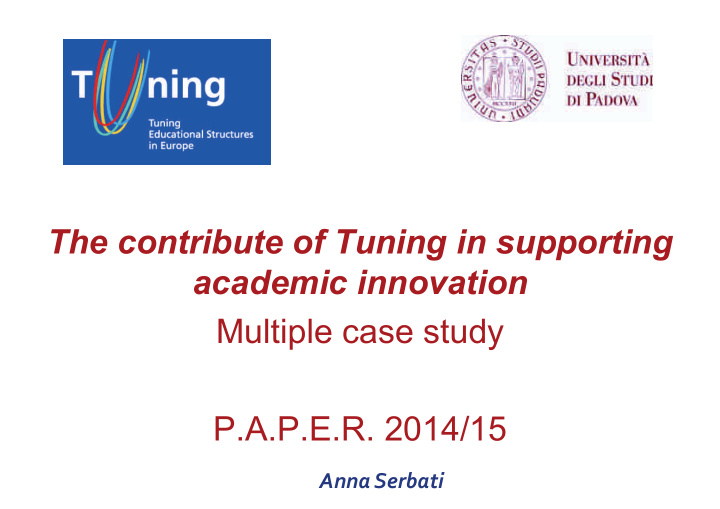



The contribute of Tuning in supporting academic innovation Multiple case study P.A.P.E.R. 2014/15 Anna Serbati
My fellowship at DITA • Within the Tuning major effort to implement the Bologna Process in Europe (González, Wagenaar, 2005) and to promote a student-centred approach in higher education institutions worldwide, this research aims at providing evidence-based good practices using a narrative-based approach . Case studies among some Tuning projects will focus on methods and tools to implement successful and innovative approaches to learning, teaching, and assessment appropriate for competence-based learning. • The research might provide elements on how the Tuning methodology has found criticalities and concrete solutions in different countries in order to develop academic innovation and to support teachers’ professional development.
A few words about Tuning approach • Tuning proceeds from the same awareness of the need for change in European higher education, started simultaneously and developed in parallel with the main underlying change processes (Bologna and Lisbon). • Its main focus has been on the re-development of teaching-learning programmes, in the perspective of lifelong learning and in view of the skills/competences (targeted Learning Outcomes) that students need to acquire in each main area of qualification.
• Considering that the Tuning Academy is already carrying out researches on Tuning impact (i.e. first Tuning impact questionnaire), the contribute of the fellowship may be in line with these activities in order to deepen and make visible the development of Tuning methodology within the institutions and its application to the real daily teaching and learning practices. • The findings of the one-month fellowship will be summarised, described and explained in a final article, which will be the outcome of the visit, to be published and disseminated in the educational networks worldwide.
• Qualitative research is based on a view that social phenomena, human dilemmas and the nature of cases are situational. The study of situations reveals experiential knowledge (Guba and Lincoln, 1984). • A multiple case study enables the researcher to explore differences within and between cases. The goal is to replicate findings across cases. Because comparisons will be drawn, it is imperative that the cases are chosen carefully so that the researcher can predict similar results across cases, or predict contrasting results based on a theory (Yin, 2003).
• Therefore, multicase study allows understanding how a phenomenon performs in different environments and can be used successfully to probe beneath the surface of a situation and to provide a rich context for understanding the phenomena under study. Main methodological sources: • Yin, R. K. (2003). Case study research: Design and methods (3rd Ed.). Thousand Oaks, CA: Sage. • Stake, R.E. (2006), Multiple Case Study Analysis. New York: The Guildford Press.
Let’s start from your previous experience and from a preliminary reading …
WEAKNESSES STRENGHTS OPPORTUNITIES THREATS What are, according to your experience and to this preliminary reading, the main strenghts, weaknesses, opportunities and threats of the methodology?
A few words about Tuning approach Set of practical TOOLS for academics / institutions to implement a three cycle system: • A methodology to design / enhance, deliver student centred degree programmes (for all three cycles) based on the Competences and Learning Outcome approach • Meta-profiles for a growing number of Sectors and Subject Areas (teachers from different universities in the same discipline work together - SAG) • A Guide to formulating degree programme profiles. Including Programme Competences and Programme Learning Outcomes • A methodology to calculate workload based credits • A platform for academics to discuss the implications of higher education reforms
Regional Tuning websites: absolute number and growth rate of hits growth rate (hits/day) Number of hits WEB PAGE (november 7th �� 17th, 2012) (checked 17 November 2012) Tuning Europe 425 4.236.231 http://www.unideusto.org/tuningeu/ Tuning LA (1st) 813 5.124.990 http://tuning.unideusto.org/tuningal/ Tuning LA (2nd) 799 290.889 http://www.tuningal.org/ Tuning Africa 325 113.129 http://www.tuningafrica.org/ Tuning Russia 708 133.263 http://www.tuningrussia.org/
The following kind of data triangulation (Denzin, 1989) are preferred: • use more than one research method on the same thing (document review and interview) • presentation of intermediate and final reports to DITA staff for comments/integrations/suggestions. Projects’ selection criteria (in progress): • Completed projects with implementation of the Tuning methodology on local curricula(Europe, Africa, Latina America, Russia)?? • projects involving the same subject area group (SAG): education
Guiding questions for selection (Stake, 2006): • are the cases relevant to the comprehension of Tuning methodology application at institutional and course level? • do the cases provide diversity across contexts? • do the cases provide good opportunities to learn about complexity and contexts? Interviewees’ selection criteria: 3-4 persons from each SAG (belonging to different universities) for each project. The SAG coordinator may be involved as a university representative, not as group manager.
Single case-study research questions (in progress) • How are different institutions developing the Tuning methodology after their involvement in a structured Tuning project? • What are the main Tuning successful products within the university at institutional and course level? • What are the main criticalities and concrete solutions in different countries regarding Tuning methodology? • What kind of network and partnership are supporting the Tuning methodology at local, regional and national levels? • What can be the contribute of Tuning methodology to teachers’ professional development and educational innovation?
Cross-cutting themes emerged from document analysis (to be enriched with themes emerging from the Interviews) According to Diamond (2002), three dimensions can be considered to improve academic quality with an integrated approach: • Faculty (individual) level • Instructional level • Organizational level
• How do I match the cross- cutting themes identified in the documents analysed with the themes emerging from the narratives? • Should I mention the cross- cutting themes in the interview protocol or should I use broader questions to allow interviewees to give their own understanding of the phenomenon?
THANK YOU FOR YOUR SUPPORT!
Recommend
More recommend